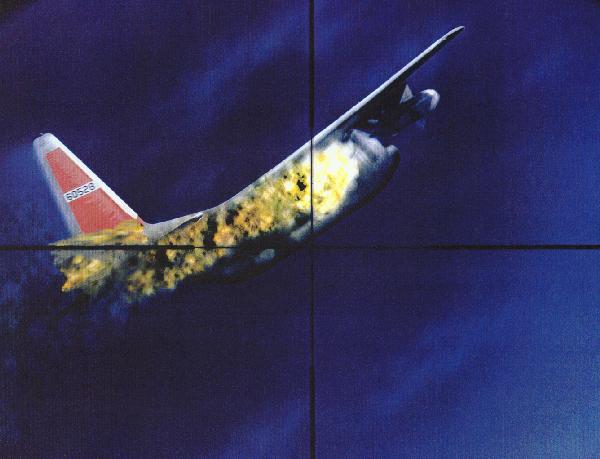 |
| The End of the Mission for 60528 |
|---|
 |
| The End of the Mission for 60528 |
|---|
A. TFR-M representatives returned to the Central Archive of the Ministry of Defense (Podolsk) to review the Air Defense Command (PVO) after action reports on the 2 September 1958 Cold War shootdown of a U.S. C -130 over Armenia. The visit was sponsored by Colonel Ivan Aleksandrovich Luchkin. The principal source document was an extremely detailed investigative commission report, with 8 enclosures, dated 4 September 1958 . The enclosures included: a summary report from Command Post 236 (which controlled the intercept); an air operations map; gun- sight photos and weapons expenditure cards; a crash site map; sketches of the crash site; a technical assessment; a forensic review; and remains photos. The investigative commission had been chaired by an Air Defense general, but also contained input from other branches of service and from the security services.
(1) The documents identified the U.S. aircraft as a C -130 , tail number 60528, serial number 3137, and production number 337824271. A plate on the aircraft suggested it was assigned to the USAF 7406th Auxiliary Squadron then based at Rhein-Main, Germany. Fragments of a TDY order found in the wreckage indicated that the aircraft had deployed to Turkey on 1 September 1958 to support an "air operation." The Soviet report stated that the C -130 was conducting border reconnaissance along the Turkish-Soviet border on the afternoon of 2 September 1958 . It crossed into Soviet airspace at 1507 hours. At that point, Soviet air defense radars had already been tracking the plane for half an hour and two flights of two MIG-17s each scrambled from the 25th Fighter Regiment's Yerevan base at approximately 1440, assuming combat air patrol stations in the vicinity of the border. The weather was good, with visibility of 15-20 kilometers.
(2 ) The first flight of MIGs was commanded by Senior Lieutenant V.V. Lopatkov. His wing-man was Senior Lieutenant H. Govrilov. The commander of the second flight was Senior Lieutenant Kutiriov. The first flight intercepted the C -130 at approximately 1508 and Lopatkov reported firing warning shots at 1509. The C -130 responded by maneuvering and trying to climb. The Soviet pilots asked for and received the command post's permission to engage the C -130 . The MIGs began their attack at 1511. All four Soviet aircraft attacked the U.S. aircraft in turn, employing cannon and rocket fire.
(3) Gun-sight photography from the third attacking MIG showed smoke and, possibly, fire coming from the C -130 's left outboard engine. The pilot of the fourth MIG reported that the C -130 was going down on fire and was beginning to break up even before he began his attack. The report indicates that seven to ten minutes elapsed between the first attack and the C -130 's crash. There was no indication of crew members attempting to exit the stricken aircraft or of parachute sightings. The report states that the C -130 exploded and burned on impact.
(4) The site sketch and photography of the crash site suggest that the C -130 had not broken up significantly prior to impact, since all major assemblies were generally in place. Fragments were found from 3 to 350 meters from the point of impact and the heat of the fire was such that metal parts fused together. The human remains recovered were charred and disfigured, virtually ashen. The fire was so intense that it apparently even precluded the technical exploitation of receivers or any other fragments recovered from the site.
(5) The Soviets found the following items at the site: partially-burned U.S., German, French, Dutch and Turkish currency; a pistol (serial # 1769459); and I.D. tags for three crew members. Seven sets of charred remains were recovered. Six sets of remains were in the crew compartment and one set in the hold. Four sets of remains were found on the first evening, while the other three were not discovered until the following day. The Soviet forensic report verified the number of remains as seven. This forensic report noted that other remains may have been present in the wreckage but that the intensity of the fire prevented their identification. [NOTE: U.S. sources indicate that six sets of remains were repatriated and that only four of these were identifiable; however, while information received from Podolsk requires further analysis, there is a possibility of the positive identification of at least one further crew member.] The photos of the wreckage suggest that no one on board could have survived the impact, explosion and fire. Colonel Luchkin commented that, if the crew's family members saw the crash site photos, they would be painfully convinced of the aircraft's total destruction and that no one still in the aircraft could have survived the crash. Nonetheless, Luchkin promised to contact a friend in the security services to attempt to verify that none of the crew parachuted from the C-130 as it was going down.
(6) TFR-M gave Colonel Luchkin a list of the other nine Cold War downings in which the U.S. side of the Joint Commission has an ongoing interest, requesting to review the Air Defense records on each of these incidents. Luchkin reiterated that the archive was very willing to cooperate with the U.S. effort and that TFR-M was welcome to return to review the other files. He promised that his assistants would isolate the appropriate records for future visits. TFR-M asked that the review begin with the records on the incidents from 8 April 1950 and 29 July 1953.
(7) The records reviewed by TFR-M were still classified Secret and Top Secret, therefore TFR-M members took notes but did not (yet) request photocopies of the material. TFR-M will take that step after all records have been reviewed.